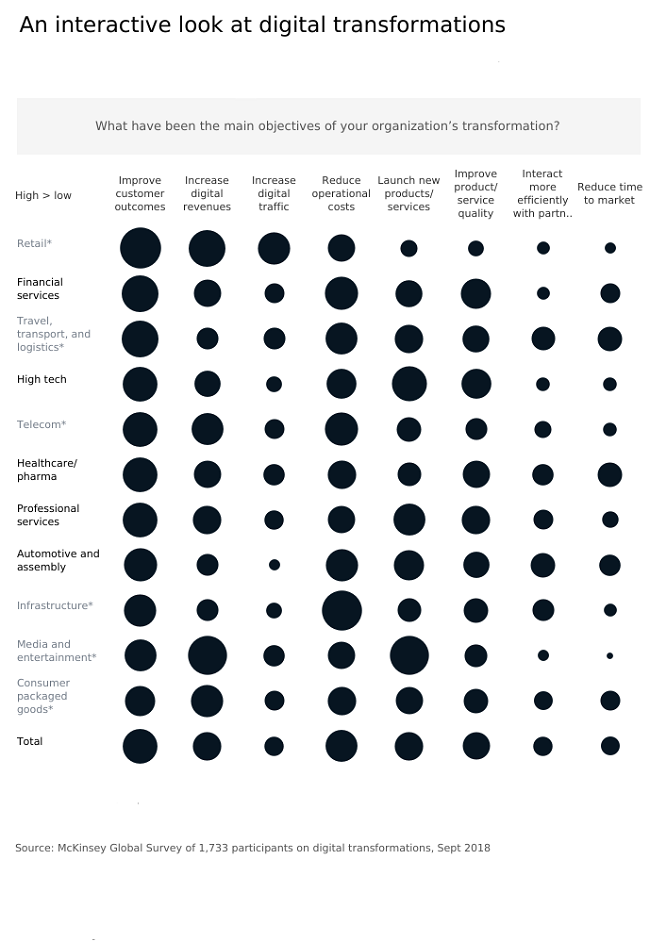5 Key Practices For A CIO To Lead Digital Transformation
With the transformation of the executive roles over the last decade, CIO's mandate has shifted from a trusted operator, only focusing on the IT team, to transforming the business, driving growth, and shaping the organization's digital future. The IT team is no longer a support function but a Business Partner. With the technical expertise, CIO's are expected to play a vital role in leading the company's digital transformation.
In a recent survey on the Global CIO, conducted by Deloitte, 58% of organizations are focusing on planning and executing a digital strategy for growth, of which only 40% of companies are led by CIO's for digital transformation. Only 13% of the organizations can successfully adapt and measure the impact of digital transformation. In a practical approach, CIOs will have to lead the digital disruption.
As George Westerman, MIT principal research scientist, says- Digital transformation marks a radical rethinking of how an organization uses technology, people, and processes to change business performance fundamentally.
To simplify, digital transformation is the integration of technologies into the business model to enhance the processes and customer experience.
Here are five critical practices for a CIO to effectively plan and implement digital transformation.
Defining The Digital Vision
The first step towards digital transformation is to have a Vision. Any Organization planning for a Digital Transformation has to find the scope and need of introducing new technology and understand the benefit of such transformation to the end-user or the customer. Be it a process-centric or a customer-centric approach towards digital transformation, a well-defined goal and vision will help the CIO and the organization to bring in any technological change successfully. Around 2000 CIO's were surveyed on their objective for digital transformation. Refer to the source here-

Facilitating Alignment Of The C-Suite and The Board Members
The leadership team must be aligned with the strategy to be implemented to drive a change across the organization. The CEO, CFO, CHRO, CDO, and other C-suite members have an equal role in digital transformation. Planning how to pass on the information to different levels in the organization, how to utilize the funds in the most effective way to ensure the finances are not disturbed, hiring and developing competent team teams is to be done well in advance.
Planning The Modus Operandi
Once the vision is in place, the next step will be planning a strategy to implement the digital transformation. The way of operating and implementing the change will be different, depending on the business's process for digital disruption. There can be various dimensions for other Industries, but in a broader view, the below four are defined:
- Customers
- Employees
- Business Process
- Business Partners
Facilitating Alignment Of The C-Suite and The Board Members
To drive a change across the organization, the leadership team has to be well aligned with the strategy to be implemented. The CEO, CFO, CHRO, CDO, and other C-suite members have an equal role in digital transformation. Planning how to pass on the information to different levels in the organization, how to utilize the funds in the most effective way to ensure the finances are not disturbed, hiring and developing competent team teams is to be done well in advance.
Developing A Tech-Workforce
The teams at the ground level execute the strategy and plans. These are the ones working on any new technology or business process or interfacing the customers & stakeholders. With the shift in technology, it is also essential to develop a competent team to use the advanced tools and technologies that are being introduced. The skill gaps of the existing teams need to be identified, and the employees with the required skill set to support the transformation need to be hired. This is where the organization's structuring, with the help of the CHRO, will help the CIO form a technology-driven workforce.
Adopting Agile Work Methodology
'Fail Fast to learn fast.' Digital Transformation needs to be agile, where teams will be open to risk-taking, innovating, and learning and unlearning during transformation. Building an environment of experimenting and innovating with the technologies and platforms available is essential to develop the teams to be habitual of changes and agility in the system. There is also a need to have a set of metrics for the leaders to measure the performance of any digital disruption and take temporary measures accordingly. Businesses can use the below three metrics to measure the impact of digital transformation:
- Process Improvement
- Financial Impact
To conclude, it is the right time and opportunity for all CIO's to emerge as Business Leader and support the larger vision of the organization.
If you are looking for a technology partner to help you scale up your organization's digital transformation, your search ends here. Virus Positive Technologies is your one-stop solution to take your organization to the next level in the disruptive world of technology. We are a boutique service provider into e-Commerce web & mobile development, testing services, affiliate frauds & customer support. Over 100+ IT professionals & engineers use the latest technologies, frameworks & hi-tech methodologies to offer impeccable and quality outsourced services from India.
Visit our Next blog about the 5 Things to Consider for Choosing the Right Technology Partner.
For more information, please visit our website, Virus Positive, or write to us at sales@viruspositive.com.







